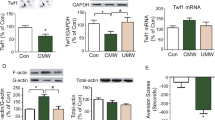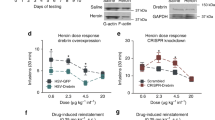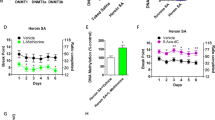Abstract
Memories associated with drug use increase vulnerability to relapse in substance use disorder (SUD), and there are no pharmacotherapies for the prevention of relapse. Previously, we reported a promising finding that storage of memories associated with methamphetamine (METH), but not memories for fear or food reward, is vulnerable to disruption by actin depolymerization in the basolateral amygdala complex (BLC). However, actin is not a viable therapeutic target because of its numerous functions throughout the body. Here we report the discovery of a viable therapeutic target, nonmuscle myosin IIB (NMIIB), a molecular motor that supports memory by directly driving synaptic actin polymerization. A single intra-BLC treatment with Blebbistatin (Blebb), a small-molecule inhibitor of class II myosin isoforms, including NMIIB, produced a long-lasting disruption of context-induced drug seeking (at least 30 days). Further, postconsolidation genetic knockdown of Myh10, the heavy chain of the most highly expressed NMII in the BLC, was sufficient to produce METH-associated memory loss. Blebb was found to be highly brain penetrant. A single systemic injection of the compound selectively disrupted the storage of METH-associated memory and reversed the accompanying increase in BLC spine density. This effect was specific to METH-associated memory, as it had no effect on an auditory fear memory. The effect was also independent of retrieval, as METH-associated memory was disrupted 24 h after a single systemic injection of Blebb delivered in the home cage. Together, these results argue for the further development of small-molecule inhibitors of NMII as potential therapeutics for the prevention of SUD relapse triggered by drug associations.
This is a preview of subscription content, access via your institution
Access options
Subscribe to this journal
Receive 12 print issues and online access
$259.00 per year
only $21.58 per issue
Buy this article
- Purchase on Springer Link
- Instant access to full article PDF
Prices may be subject to local taxes which are calculated during checkout





Similar content being viewed by others
References
Childress AR, Mozley PD, McElgin W, Fitzgerald J, Reivich M, O'Brien CP . Limbic activation during cue-induced cocaine craving. Am J Psychiatry 1999; 156: 11–18.
Phillips KA, Epstein DH, Preston KL . Psychostimulant addiction treatment. Neuropharmacology 2014; 87C: 150–160.
Price KL, Baker NL, McRae-Clark AL, Saladin ME, Desantis SM, Santa Ana EJ et al. A randomized, placebo-controlled laboratory study of the effects of D-cycloserine on craving in cocaine-dependent individuals. Psychopharmacology (Berl) 2013; 226: 739–746.
Botreau F, Paolone G, Stewart J . d-Cycloserine facilitates extinction of a cocaine-induced conditioned place preference. Behav Brain Res 2006; 172: 173–178.
Malvaez M, McQuown SC, Rogge GA, Astarabadi M, Jacques V, Carreiro S et al. HDAC3-selective inhibitor enhances extinction of cocaine-seeking behavior in a persistent manner. Proc Natl Acad Sci USA 2013; 110: 2647–2652.
Myers KM, Carlezon WA Jr, Davis M . Glutamate receptors in extinction and extinction-based therapies for psychiatric illness. Neuropsychopharmacology 2011; 36: 274–293.
Peters J, Kalivas PW, Quirk GJ . Extinction circuits for fear and addiction overlap in prefrontal cortex. Learn Mem 2009; 16: 279–288.
Bird MK, Lohmann P, West B, Brown RM, Kirchhoff J, Raymond CR et al. The mGlu5 receptor regulates extinction of cocaine-driven behaviours. Drug Alcohol Depend 2014; 137: 83–89.
Miller CA, Marshall JF . Molecular substrates for retrieval and reconsolidation of cocaine-associated contextual memory. Neuron 2005; 47: 873–884.
Jones B, Bukoski E, Nadel L, Fellous J-M . Remaking memories: reconsolidation updates positively motivated spatial memory in rats. Learn Mem 2012; 19: 91–98.
Monfils M-H, Cowansage KK, Klann E, LeDoux JE . Extinction-reconsolidation boundaries: key to persistent attenuation of fear memories. Science 2009; 324: 951–955.
Otis JM, Werner CT, Mueller D . Noradrenergic regulation of fear and drug-associated memory reconsolidation. Neuropsychopharmacology 2014; 40: 793–803.
Lee TH, Szabo ST, Fowler JC, Mannelli P, Mangum OB, Beyer WF et al. Pharmacologically-mediated reactivation and reconsolidation blockade of the psychostimulant-abuse circuit: a novel treatment strategy. Drug Alcohol Depend 2012; 124: 11–18.
Lee JL, Di Ciano P, Thomas KL, Everitt BJ . Disrupting reconsolidation of drug memories reduces cocaine-seeking behavior. Neuron 2005; 47: 795–801.
Childress AR, Hole AV, Ehrman RN, Robbins SJ, McLellan AT, O'Brien CP . Cue reactivity and cue reactivity interventions in drug dependence. NIDA Res Monogr 1993; 137: 73–95.
Young EJ, Aceti M, Griggs EM, Fuchs RA, Zigmond Z, Rumbaugh G et al. Selective, retrieval-independent disruption of methamphetamine-associated memory by actin depolymerization. Biol Psychiatry 2014; 75: 96–104.
Kasai H, Fukuda M, Watanabe S, Hayashi-Takagi A, Noguchi J . Structural dynamics of dendritic spines in memory and cognition. Trends Neurosci 2010; 33: 121–129.
Lai CSW, Franke TF, Gan W-B . Opposite effects of fear conditioning and extinction on dendritic spine remodelling. Nature 2012; 483: 87–91.
Yang G, Pan F, Gan W-B . Stably maintained dendritic spines are associated with lifelong memories. Nature 2009; 462: 920–924.
Kasai H, Matsuzaki M, Noguchi J, Yasumatsu N, Nakahara H . Structure–stability–function relationships of dendritic spines. Trends Neurosci 2003; 26: 360–368.
Smart FM, Halpain S . Regulation of dendritic spine stability. Hippocampus 2000; 10: 542–554.
Star EN, Kwiatkowski DJ, Murthy VN . Rapid turnover of actin in dendritic spines and its regulation by activity. Nat Neurosci 2002; 5: 239–246.
Kim C-H, Lisman JE . A role of actin filament in synaptic transmission and long-term potentiation. J Neurosci 1999; 19: 4314–4324.
Lin B, Kramár EA, Bi X, Brucher FA, Gall CM, Lynch G . Theta stimulation polymerizes actin in dendritic spines of hippocampus. J Neurosci 2005; 25: 2062–2069.
Rex CS, Gavin CF, Rubio MD, Kramar EA, Chen LY, Jia Y et al. Myosin IIb regulates actin dynamics during synaptic plasticity and memory formation. Neuron 2010; 67: 603–617.
Krucker T, Siggins GR, Halpain S . Dynamic actin filaments are required for stable long-term potentiation (LTP) in area CA1 of the hippocampus. Proc Natl Acad Sci 2000; 97: 6856–6861.
Mantzur L, Joels G, Lamprecht R . Actin polymerization in lateral amygdala is essential for fear memory formation. Neurobiol Learn Mem 2009; 91: 85–88.
Rehberg K, Bergado-Acosta JR, Koch JC, Stork O . Disruption of fear memory consolidation and reconsolidation by actin filament arrest in the basolateral amygdala. Neurobiol Learn Mem 2010; 94: 117–126.
Fischer A, Sananbenesi F, Schrick C, Spiess J, Radulovic J . Distinct roles of hippocampal de novo protein synthesis and actin rearrangement in extinction of contextual fear. J Neurosci 2004; 24: 1962–1966.
Gavin CF, Rubio MD, Young E, Miller C, Rumbaugh G . Myosin II motor activity in the lateral amygdala is required for fear memory consolidation. Learn Mem 2012; 19: 9–14.
Rosenfeld SS, Xing J, Chen LQ, Sweeney HL . Myosin IIb is unconventionally conventional. J Biol Chem 2003; 278: 27449–27455.
Miller CA, Marshall JF . Altered prelimbic cortex output during cue-elicited drug seeking. J Neurosci 2004; 24: 6889–6897.
Aguilar-Valles A, Vaissiere T, Griggs EM, Mikaelsson MA, Takacs IF, Young EJ et al. Methamphetamine-associated memory is regulated by a writer and an eraser of permissive histone methylation. Biol Psychiatry 2013; 76: 57–65.
Langmead B, Trapnell C, Pop M, Salzberg SL . Ultrafast and memory-efficient alignment of short DNA sequences to the human genome. Genome Biol 2009; 10: R25.
Trapnell C, Pachter L, Salzberg SL . TopHat: discovering splice junctions with RNA-Seq. Bioinformatics 2009; 25: 1105–1111.
Anders S, Huber W . Differential expression analysis for sequence count data. Genome Biol 2010; 11: R106.
Griggs EM, Young EJ, Rumbaugh G, Miller CA . MicroRNA-182 regulates amygdala-dependent memory formation. J Neurosci 2013; 33: 1734–1740.
Guissouma H, Froidevaux MS, Hassani Z, Demeneix BA . In vivo siRNA delivery to the mouse hypothalamus confirms distinct roles of TR beta isoforms in regulating TRH transcription. Neurosci Lett 2006; 406: 240–243.
McQuown SC, Barrett RM, Matheos DP, Post RJ, Rogge GA, Alenghat T et al. HDAC3 is a critical negative regulator of long-term memory formation. J Neurosci 2011; 31: 764–774.
Miller CA, Marshall JF . Altered Fos expression in neural pathways underlying cue-elicited drug seeking in the rat. Eur J Neurosci 2005; 21: 1385–1393.
Stinus L, Cador M, Zorrilla EP, Koob GF . Buprenorphine and a CRF1 antagonist block the acquisition of opiate withdrawal-induced conditioned place aversion in rats. Neuropsychopharmacology 2005; 30: 90–98.
Mead AN, Stephens DN . CNQX but not NBQX prevents expression of amphetamine-induced place preference conditioning: a role for the glycine site of the NMDA receptor, but not AMPA receptors. J Pharmacol Exp Ther 1999; 290: 9–15.
Newton PM, Orr CJ, Wallace MJ, Kim C, Shin HS, Messing RO . Deletion of N-type calcium channels alters ethanol reward and reduces ethanol consumption in mice. J Neurosci 2004; 24: 9862–9869.
Munoz-Cuevas FJ, Athilingam J, Piscopo D, Wilbrecht L . Cocaine-induced structural plasticity in frontal cortex correlates with conditioned place preference. Nat Neurosci 2013; 16: 1367–1369.
Kovács M, Tóth J, Hetényi C, Málnási-Csizmadia A, Sellers JR . Mechanism of Blebbistatin inhibition of myosin II. J Biol Chem 2004; 279: 35557–35563.
Fuchs RA, Evans KA, Ledford CC, Parker MP, Case JM, Mehta RH et al. The role of the dorsomedial prefrontal cortex, basolateral amygdala, and dorsal hippocampus in contextual reinstatement of cocaine seeking in rats. Neuropsychopharmacology 2004; 30: 296–309.
Wells AM, Arguello AA, Xie X, Blanton MA, Lasseter HC, Reittinger AM et al. Extracellular signal-regulated kinase in the basolateral amygdala, but not the nucleus accumbens core, is critical for context-response-cocaine memory reconsolidation in rats. Neuropsychopharmacology 2013; 38: 753–762.
Reichel CM, See RE . Modafinil effects on reinstatement of methamphetamine seeking in a rat model of relapse. Psychopharmacology 2010; 210: 337–346.
Rubio FJ, Liu QR, Li X, Cruz FC, Leao RM, Warren BL et al. Context-induced reinstatement of methamphetamine seeking is associated with unique molecular alterations in fos-expressing dorsolateral striatum neurons. J Neurosci 2015; 35: 5625–5639.
Bond LM, Tumbarello DA, Kendrick-Jones J, Buss F . Small-molecule inhibitors of myosin proteins. Future Med Chem 2013; 5: 41–52.
Wang X, Chong M, Wang H, Zhang J, Xu H, Liu D . Block the function of nonmuscle myosin II by blebbistatin induces zebrafish embryo cardia bifida. In Vitro Cell Dev Biol Anim 2014; 51: 211–217.
Eddinger TJ, Meer DP, Miner AS, Meehl J, Rovner AS, Ratz PH . Potent inhibition of arterial smooth muscle tonic contractions by the selective myosin II inhibitor, blebbistatin. J Pharmacol Exp Ther 2007; 320: 865–870.
Rubio MD, Johnson R, Miller CA, Huganir RL, Rumbaugh G . Regulation of synapse structure and function by distinct myosin II motors. J Neurosci 2011; 31: 1448–1460.
Cheng D, Hoogenraad CC, Rush J, Ramm E, Schlager MA, Duong DM et al. Relative and absolute quantification of postsynaptic density proteome isolated from rat forebrain and cerebellum. Mol Cell Proteomics 2006; 5: 1158–1170.
Peng J, Kim MJ, Cheng D, Duong DM, Gygi SP, Sheng M . Semiquantitative proteomic analysis of rat forebrain postsynaptic density fractions by mass spectrometry. J Biol Chem 2004; 279: 21003–21011.
Ertl P, Rohde B, Selzer P . Fast calculation of molecular polar surface area as a sum of fragment-based contributions and its application to the prediction of drug transport properties. J Med Chem 2000; 43: 3714–3717.
Hitchcock SA, Pennington LD . Structure−brain exposure relationships. J Med Chem 2006; 49: 7559–7583.
Crawley JN . What's Wrong With My Mouse: Behavioral Phenotyping of Transgenic and Knockout Mice, 2nd (edn). Wiley Press: Hoboken, NJ, 2007; pp 44–57.
Feng G, Mellor RH, Bernstein M, Keller-Peck C, Nguyen QT, Wallace M et al. Imaging neuronal subsets in transgenic mice expressing multiple spectral variants of GFP. Neuron 2000; 28: 41–51.
Heinrichs SC, Leite-Morris KA, Guy MD, Goldberg LR, Young AJ, Kaplan GB . Dendritic structural plasticity in the basolateral amygdala after fear conditioning and its extinction in mice. Behav Brain Res 2013; 248: 80–84.
Pignataro A, Middei S, Borreca A, Ammassari-Teule M . Indistinguishable pattern of amygdala and hippocampus rewiring following tone or contextual fear conditioning in C57BL/6 mice. Front Behav Neurosci 2013; 7: 156.
Medeiros NA, Burnette DT, Forscher P . Myosin II functions in actin-bundle turnover in neuronal growth cones. Nat Cell Biol 2006; 8: 216–226.
Daley DC, Mercer D . Therapy Manuals for Drug Addiction. NIH: : Bethesda, MD, USA, 2002.
Tran-Nguyen LT, Fuchs RA, Coffey GP, Baker DA, O'Dell LE, Neisewander JL . Time-dependent changes in cocaine-seeking behavior and extracellular dopamine levels in the amygdala during cocaine withdrawal. Neuropsychopharmacology 1998; 19: 48–59.
West EA, Saddoris MP, Kerfoot EC, Carelli RM . Prelimbic and infralimbic cortical regions differentially encode cocaine-associated stimuli and cocaine-seeking before and following abstinence. Eur J Neurosci 2014; 39: 1891–1902.
Grimm JW, Hope BT, Wise RA, Shaham Y . Neuroadaptation. Incubation of cocaine craving after withdrawal. Nature 2001; 412: 141–142.
Grimm JW, Lu L, Hayashi T, Hope BT, Su TP, Shaham Y . Time-dependent increases in brain-derived neurotrophic factor protein levels within the mesolimbic dopamine system after withdrawal from cocaine: implications for incubation of cocaine craving. J Neurosci 2003; 23: 742–747.
Lee BR, Ma YY, Huang YH, Wang X, Otaka M, Ishikawa M et al. Maturation of silent synapses in amygdala-accumbens projection contributes to incubation of cocaine craving. Nat Neurosci 2013; 16: 1644–1651.
Ma YY, Lee BR, Wang X, Guo C, Liu L, Cui R et al. Bidirectional modulation of incubation of cocaine craving by silent synapse-based remodeling of prefrontal cortex to accumbens projections. Neuron 2014; 83: 1453–1467.
Straight AF, Cheung A, Limouze J, Chen I, Westwood NJ, Sellers JR et al. Dissecting temporal and spatial control of cytokinesis with a myosin II Inhibitor. Science 2003; 299: 1743–1747.
Kepiro M, Varkuti BH, Vegner L, Voros G, Hegyi G, Varga M et al. para-Nitroblebbistatin, the non-cytotoxic and photostable myosin II inhibitor. Angew Chem Int Ed Engl 2014; 53: 8211–8215.
Hawrylycz MJ, Lein ES, Guillozet-Bongaarts AL, Shen EH, Ng L, Miller JA et al. An anatomically comprehensive atlas of the adult human brain transcriptome. Nature 2012; 489: 391–399.
Acknowledgements
We thank the Scripps Florida Genomics Core for their assistance with RNA sequencing, the Scripps Florida Behavior Core for providing behavioral equipment, Dr Christine Gall for her helpful comments and Colton Hoffer for technical assistance. This work was supported by grants from the National Institute on Drug Abuse (R01DA034116, R01DA034116S1 and R21DA036376 to CAM), National Institute for Neurological Disorders and Stroke (R01NS064079 to GR) and National Institute for Mental Health (R01MH096847 to GR) and the Brain and Behavior Research Foundation (NARSAD Young Investigator Awards to AMB and SES).
Author information
Authors and Affiliations
Corresponding author
Ethics declarations
Competing interests
The authors declare no conflict of interest.
Additional information
Supplementary Information accompanies the paper on the Molecular Psychiatry website
Supplementary information
Rights and permissions
About this article
Cite this article
Young, E., Blouin, A., Briggs, S. et al. Nonmuscle myosin IIB as a therapeutic target for the prevention of relapse to methamphetamine use. Mol Psychiatry 21, 615–623 (2016). https://doi.org/10.1038/mp.2015.103
Received:
Revised:
Accepted:
Published:
Issue Date:
DOI: https://doi.org/10.1038/mp.2015.103
This article is cited by
-
Reflex memory theory of acquired involuntary motor and sensory disorders
The Egyptian Journal of Neurology, Psychiatry and Neurosurgery (2021)
-
MicroRNA regulation of persistent stress-enhanced memory
Molecular Psychiatry (2020)
-
Blebbistatin reveals beneficial effects on the cystometric parameters in an animal model of detrusor overactivity
Naunyn-Schmiedeberg's Archives of Pharmacology (2019)
-
Reversal of Cocaine-Associated Synaptic Plasticity in Medial Prefrontal Cortex Parallels Elimination of Memory Retrieval
Neuropsychopharmacology (2017)
-
Inhibiting Rho kinase promotes goal-directed decision making and blocks habitual responding for cocaine
Nature Communications (2017)



